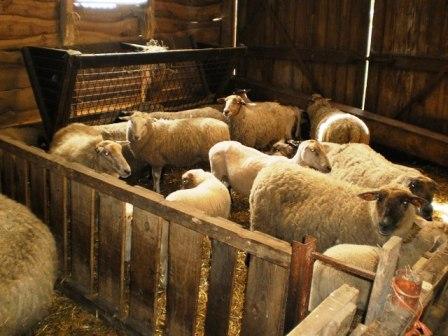For thousands of years ago we began animals that we found useful to keep with us. That's a lot easier than having to detect and capture them in the wild.
 Often they served simply as food: rabbit, pig and others.
Often they served simply as food: rabbit, pig and others.
Or their products were interesting.
Poultry have the advantage that they lay also eggs. And deliver down.
Cows, sheep and goats also delivered milk.
Sheep also have wool.
Donkey and horse, but also cows, oxen, camels... could also carry loads or pull carts.
And bees produce great honey. Silkworm silk.
Dogs also wore charges. And traced wild. And warned of danger, helped chase or retrieve prey. And were fine company.
And the cat made sure our winter stock was not eaten by rodents.
| Type | Jr BC | Location |
| Dog | 15000 + | Various places |
| Goat | 10000 | Asia and Middle East |
| Sheep | 8000 | Asia and Middle East |
| Pig | 8000 | China |
| Cow | 8000 | India, Middle-East, and Sub-Sahara |
| Cat | 7000 | Mediterranean |
| Chicken | 6000 | Southeast Asia |
| Donkey | 5000 | Egypt |
| Horse | 4000 | Ukraine |
Within species and subspecies of organisms (plants, animals ..), groups adapted by humans through breeding are called a race.
Prehistoric baby bottles have been found in Bavarian children's graves. They appeared on the European continent around 5000 BC, and became increasingly popular during the Bronze Age and Iron Age. The diameter is five to ten centimeters, and they are equipped with a narrow spout. They are decorated, some have the shape of imaginary animals. According to research, the babies probably received cow, goat or sheep milk.
Animals who were domesticating we will probably, unlike many other species, never eradicate. Perhaps it is also a survival strategy: adapt or scram?
Although: rats, mice, cockroaches, ants, flies... They will survive us anyway.
I later want to marry a woman who loves a lot animals like me.
The Russian Dmitri Belyaev began in 1958 with the domestication of Siberian foxes. He selected the least aggressive animals. After only 12 generations occurred significant behavioral and psychological changes, and morphological, neurochemical and genetic differences. The animals were friendlier, like ordinary dogs, and wagged their tails and started barking. They got a white spot on their head, ears became flap ears and the typical musk odor decreased. They were smaller and more communicative with respect to people. Similar processes have certainly occurred in the making of other livestock and pets tame.
Animal husbandry
The farmyard is the vacant lot between the buildings of a farm (yard) or castle (the courtyard, sometimes with an upper court). Here were farmyard animals kept: poultry, rabbits and pets. Poultry or domestic fowl are ground-dwelling birds that do not fly far and high. The usually tame house bird is kept for eggs or meat, or for decoration.
'Wonderchicken' is an early bird: a fossil skull of a 66.7 million years old found in Sint-Pietersberg (Maastricht, the Netherlands) in 2000 is the oldest fossil of a modern bird, an ancestor of our poultry (Galloanserae, chickens and goose-like). This Asteriornis maastrichtensis must have weighed about 390 grams.
Under small livestock are sheep, goats and pigs counted. Cows and horses are called cattle.
The last aurochs was slain in 1627 in Poland.
